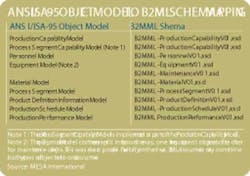Close Gap For Adaptive Manufacturing
The need for enterprise/shop-floor systems integration is driving manufacturers to link their human-machine interface/supervisory control and data acquisition (HMI/SCADA) and manufacturing execution systems (MES) on the plant floor with their enterprise resource planning (ERP) and other business systems on the top floor. Manufacturers are realizing that their supply chain plans and ERP systems cannot truly support demand-driven business processes without real-time information on events taking place in the factory.As supply chains become faster, there is little room for mistakes. As a result, there are many questions about the shop floor that management, planners, suppliers and salespeople have to answer. These include:•How much raw material has been consumed?•What specific processes were used to create products?•What batches are in process?These questions can’t be answered, due to the “gap” between the plant floor (MES, HMI and shop-floor automation applications) and enterprise systems (ERP and supply chain management, or SCM, applications).Currently, ERP and SCM systems create production and distribution plans that are designed to meet customer commitments. Those plans will not be accurate unless the ERP and SCM systems know exactly what is happening on the plant floor. These systems operate on the assumption that a plant has the capacity to make a certain number of parts, but they have no way of knowing how many machines are down or how many workers are out at any given time. Also, these systems lose visibility once a production order is released to the floor.To bridge this gap, ERP and SCM systems need access to detailed, timely shop-floor information. The idea of linking enterprise systems into shop floor systems has been around for a while. However, the technology to make this integration a reality is more recent.Gap-bridging technologyIntegration infrastructures enable ERP and SCM systems to connect to the shop-floor software applications. In leveraging
the ANSI/ISA-95 industry standard for inter- and intra-manufacturing enterprise integration with support from B2MML schemas developed by the World Batch Forum to implement the ANSI/ISA-95 standard, software vendors can create a strong solution for end users. B2MML, which stands for Business-to-Manufacturing Markup Language, conforms to the American National Standards Institute/Instrumentation, Systems and Automation Society ANSI/ISA-95 standard as shown in the table.Additionally, different adapters may be available in an integration infrastructure for communication between ERP and the control or MES systems. Examples from enterprise solution providers include: hypertext transfer protocol/HTTP over secure socket layer (HTTP/HTTPs), file/file transfer protocol (File/FTP), Java Database Connectivity (JDBC), Java Message Service (JMS), Simple Object Access Protocol (SOAP) and Remote Function Call (RFC) adapters. In summary, top-floor systems and shop-floor systems require integration to adapt to changes. Solution providers both on the ERP side and the production MES/Control side are providing integration between these systems through the ANSI/ISA-95 standards and B2MML messages. Integration helps companies meet the information needs of the business—reducing users’ times to reach full production levels for new products; enabling vendors to supply appropriate tools for implementing integration of control systems to enterprise systems and users to better identify their needs; reducing the costs of automating manufacturing processes; optimizing supply chains; and reducing life-cycle engineering efforts. Satya Narayan Sahu, [email protected], is Solution Manager, Application Solution Management, SAP Labs India Pvt. Ltd., inBangalore , India . The author represents MESA International, www.mesa.org.
the ANSI/ISA-95 industry standard for inter- and intra-manufacturing enterprise integration with support from B2MML schemas developed by the World Batch Forum to implement the ANSI/ISA-95 standard, software vendors can create a strong solution for end users. B2MML, which stands for Business-to-Manufacturing Markup Language, conforms to the American National Standards Institute/Instrumentation, Systems and Automation Society ANSI/ISA-95 standard as shown in the table.Additionally, different adapters may be available in an integration infrastructure for communication between ERP and the control or MES systems. Examples from enterprise solution providers include: hypertext transfer protocol/HTTP over secure socket layer (HTTP/HTTPs), file/file transfer protocol (File/FTP), Java Database Connectivity (JDBC), Java Message Service (JMS), Simple Object Access Protocol (SOAP) and Remote Function Call (RFC) adapters. In summary, top-floor systems and shop-floor systems require integration to adapt to changes. Solution providers both on the ERP side and the production MES/Control side are providing integration between these systems through the ANSI/ISA-95 standards and B2MML messages. Integration helps companies meet the information needs of the business—reducing users’ times to reach full production levels for new products; enabling vendors to supply appropriate tools for implementing integration of control systems to enterprise systems and users to better identify their needs; reducing the costs of automating manufacturing processes; optimizing supply chains; and reducing life-cycle engineering efforts. Satya Narayan Sahu, [email protected], is Solution Manager, Application Solution Management, SAP Labs India Pvt. Ltd., in

